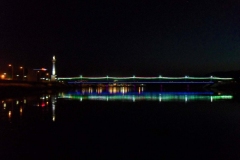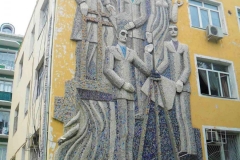Khujand is the city in the north of Tajikistan and the administrative center of the Sughd region. It is the second largest city in Tajikistan in terms of population after its capital city – Dushanbe. According to the census data, as of the 1st of January 2019 181, 600 people resided in Khujand city. Khujand is one of the most ancient cities in Central Asia. Just like many other ancient cities it was founded by the river – the great river of Syrdarya.

Khujand is a river city while Syrdarya is partially an urban river. The river serves as the central axis of the city, structuring its mental, historical and moral geographies, dividing the city into the Left and the Right banks.
Both the city and the river have been given many different names over the long history of their existence. Both have undergone many changes and transformations. There have been great changes in the riverine infrastructure – bridges have been built, systems of irrigation channels, great dams and hydropower stations along with large industrial ventures were built along the river. As a result, the terrain, the wildlife, the economic and social lives of people living along the river dramatically changed as well. This part of the Ferghana valley has changed its administrative affiliation many times – belonging to different state structures at different times. Likewise, the region’s population has also always been in flux due to migration flows caused by conquest and other political, economic and social changes in the life of this land.

The city of Hujand, according to historical sources, was founded by Alexander the Great of Macedonia, during his conquest of the region, and was named Alexandria Eschate (The Farthest City of Alexander). During the time of Russian imperial domination of the region the city was called Hojent (the Russian pronounciation of local Hujand), while during the Soviet period between 1936 and 1991 the city was renamed into Leninabad to honour Vladimir Lenin. The river also bore different names at different historical periods – Tanais, Yaxartes, and Syrdarya.
A historical of the ancient world Flavius in the second century wrote: “Alexander [the Great] himself decided to establish a city on Tanais river, calling it by his own name”. Ancient Hujand was the center for trade and industry. The river was used for transporting the goods on boats. For their servicing, across from the city’s walls, on the other bank of the river, there were guesthouses for the traders from Chach and Ferghana. A 19th century geographer Muqaddasi wrote: “Hujand is the city of delight, there is no other city in this land that would compare to its pleasantness. A river flows in the middle of it and a mountain is adjacent to it … it is praised by the wisemen and poets”. Hujand was also mentioned in the memoires of Bobur (Babur Name) – the last of the Tumurid dynasty and the founder of the Great Mughals empire in the north of India.
The river also played an important role in the defense of the city from invaders. Thus for instance was the case during the defense of the city against the troops of Chengizkhan by Temur Malik in 1220.
“Shahri nav” (New city) was the name given to the Russian colonial settlement in Khujand after the conquest of the city by the Russian imperial army. The location for the Russian quarters was chosen on the thin stripe of land between the river and the city wall up to the wooden bridge stretching across the Syrdarya. This stretch of land was often flooded and could not accommodate the growing settler population, which eventually was relocated closer to the newest trade route – the freshly constructed rail road.

“The siege and the storm of Hujand citadel between 17th and 24th of May 1877”
The City of Lenin
In the period between 1936 and 1991 the city of Hujand bore the name of Leninabad, or the “City of Lenin”. An important part of the the Soviet development project was the idea of the electrification of the entire country. In Central Asia large dam and hydropower stations on the rivers fed by glaciers were hailed not simply as infrastructural projects but as part of the grand plan to transform the nature in the service of construction of communist future.

Official sources of the early Soviet period as well as rhetoric from the 1960s depict the process of the construction of the great hydroelectric power stations in heroic terms, using the metaphors of ‘taming the wild rivers’ and ‘conquest of the Hungry Steppe’.

During the Soviet period the city of Khujand ‘stepped over onto the right bank’ of the river – a new socialist city grew on the previously uninhabited side of Syrdarya. The stony mountainous bank of the Syrdarya was now housing the new-style micro districts. In the book titled “The architectural heritage of Khujand” authored by Mukimov and Mamadjanova, they write: “And of course, the emblem of the city is the Syrdarya, dressed in the concrete ‘dress’ of the promenade and adorned with the green necklace of the parks along the river banks, beautiful bridges, joining the two banks into a single unified city complex” (1993, 32).
River and sociality
The river encourages multiple and unique forms of both public and covert sociality. Historical sources point out that the river bank has long been the favoured location for conducting business and pastime among Hujandis. Local men would frequent alou-khanas – the guesthouses and places for social gatherings as well as tea houses, which also served as hotels and diners for the locals where they spent many hours on the wooden platforms along the river bank. Bath houses were also usually designated as male-only spaces, while women’s visitation of baths was significantly restricted compared to the counties of the Middle East, for instance.
These days too the public beach on the Right bank is home to a small community of Hujandis (almost exclusively male) who gather here at dawn to engage in physical exercise, to swim in the river, and later drink tea, play chess or backgammon and exchange the latest news. Not far from the beach, later in the day, men meet in the shade under one of the city bridges, where a secret speakeasy is hidden from sight. At sundown one can observe a few lone fishers on the banks of the river, although many complain that their catch is diminishing by the year. Even further upstream, families picnic on the shores of the Tajik sea, men swimming in their underwear, women only going into the water fully clothed. Resorts located on ‘seashore’, which is an artificial reservoir created as a result of damming of the river for the Kayrakkum HPP in 1956, have a reputation as places where prostitutes flock during the summer season. Finally, the river is one of the choices of the province’s and the city’s many suicides, most of whom are women and adolescents. Thus the human-river interactions and access to the river’s many resources are highly gendered.
Gender and swimming
When Mohira Suyarkulova conducted her field work in Hujand during the summers of 2017 and 2018, she noticed that men and women engage with the river differently. One such example of this difference is how different groups enjoy the opportunity to swim in the river.
According to the spoken and unspoken norms of conduct, men can swim without any embarrassment or shame in swimming trunks or even in their underwear, while women only enter the water fully dressed in traditional Tajik gown and undergarments (long pants covering the entire length of the legs). Gendered norms of modesty and chastity for women define the water’s edge as the space where the rules of sexuality and gender are at risk and therefore need to be more strictly enforced. Thus practically all public spaces by the water – beaches, swimming pools and teahouses along the the riverside are viewed as exclusively male spaces. This means that women do not get a chance to learn how to swim, while their mere presence in the ‘forbidden’ spaces may seriously harm their reputation.

Boys on the beach on the Tajik Sea (Kairakkum reservoir), during summer of 2017. Photo by Mohira Suyarkulova




